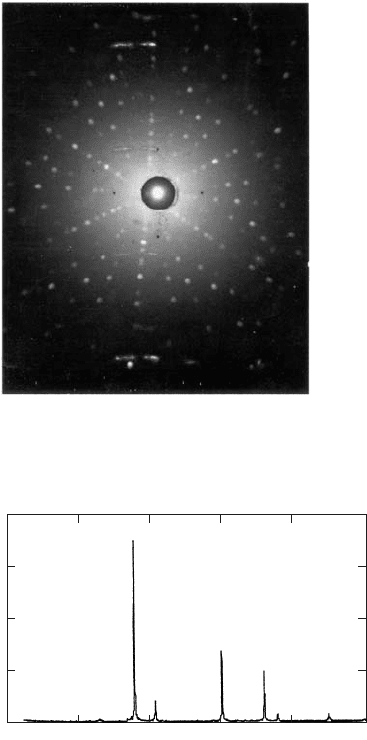Gersten J.I., Smith F.W. The Physics and Chemistry of Materials
Подождите немного. Документ загружается.

414 CHARACTERIZATION OF MATERIALS
Positron beams are used in positron annihilation spectroscopy (PAS) and positive muon
beams are used in the technique of muon-precession spectroscopy (
µPS).
The chapter also touches briefly on transport measurements of electrical resistivity,
the Hall effect, thermal conductivity, thermopower, and the Peltier coefficient. It
describes some magnetic characterization tools, such as the Foner magnetometer, the
Faraday balance, and the ac bridge. The SQUID magnetometer is discussed in the
textbook in Section 16.7.
†
Not all methods of characterization are of equal importance. Such techniques as
XRD and NMR are more universally employed than others such as LEEM, EXAFS,
and HRTEM. Therefore, more space is devoted in the chapter to the former than to
the latter techniques. Nevertheless, all the methods in the chapter (as well as others)
are used to characterize materials and so should be understood.
DIFFRACTION TECHNIQUES
In this section various diffraction techniques are studied. The most important is x-ray
diffraction, which provides information about the long-range order in the bulk of the
material. Low-energy electron diffraction provides similar information for the surface
of the material. Reflection high-energy electron diffraction and neutron diffraction are
also very useful in determining the structure. In particular, neutron scattering is sensitive
to the magnetic ordering of a solid.
W22.2 X-ray Diffraction
When a beam of x-rays interacts with an arbitrary material its atoms may scatter the
rays into all possible directions. In a crystalline solid, however, the atoms are arranged
in a periodic array and this imposes strong constraints on the resulting diffraction
pattern. It will be assumed for now that the temperature is sufficiently low that the
atoms may be regarded as being frozen in position. Diffraction was introduced in
Chapter 3, where the emphasis was on the kinematical aspects of the diffraction. In
Section 3.4 the Bragg and von Laue points of view were stated and compared.
In the Bragg description, x-ray diffraction (XRD) is brought about by the construc-
tive interference of waves scattered from successive lattice planes in the crystal. Each
plane actually scatters from 10
4
to 10
3
of the incident wave. Referring to Fig. 3.6, let
an incident beam of wave vector k impinge on a set of lattice planes, the rays making
an angle with respect to the planes. Attention is restricted to the case of specular
elastic scattering, so the outgoing scattered beam, of wave vector k
0
, also makes an
angle with these planes and
k
0
D k. W22.1
The angle of deviation between the outgoing and incident rays is D 2. The sepa-
ration between neighboring planes is denoted by d. The Bragg condition is given by
†
The material on this home page is supplemental to The Physics and Chemistry of Materials by
Joel I. Gersten and Frederick W. Smith. Cross-references to material herein are prefixed by a “W”; cross-
references to material in the textbook appear without the “W.”

CHARACTERIZATION OF MATERIALS 415
Eq. (3.52). Constructive interference between successive paths occurs when the path
difference equals an integer number of wavelengths.
Von Laue regarded x-ray diffraction as coming about due to the scattering of photons
from the periodic lattice. Since the crystal possesses a discrete translational symmetry,
there is only wave-vector conservation modulus a reciprocal lattice vector G.Theinci-
dent and outgoing wave vectors have the same magnitude and are related by Eq. (3.54).
It follows that
G
2
C 2G · k D 0 W22.2
As a result, only very specific directions of the incident wave vector k will result in
diffracted beams.
There are at least four ways that one may perform x-ray diffraction experiments:
1. Using a broadband (nonmonochromatic) x-ray source and looking at the back-
reflection. By utilizing a broadband source such as is produced by bremsstrahlung,
there will be a spread of frequencies and hence a spread of wave-vector magni-
tudes. Even if the angle of incidence is held fixed, there will be some values of
k for which Laue backscattering will occur.
2. Using a diverging (noncollimated) beam of x-rays. Similarly, by using a beam
with a spread of angles, it is possible for the Bragg formula to be satisfied even
if k is held fixed.
3. Using a monochromatic and collimated source but rotating the crystal until the
diffraction condition is met. It is also possible to keep the beam unidirectional
and monochromatic but to rotate the sample through some angular trajectory.
Whenever the angle is such that the Bragg condition is met, diffraction will
occur.
4. Diffracting the monochromatic x-rays from a powder. In a powder there are
mesoscopic-sized crystals oriented in arbitrary directions. If the x-ray beam
impinges on such a powder there will be some orientations for which will
satisfy the Bragg condition. Having fixed the direction that k makes with the
normal to the crystal, any rotation of the crystal around k will still satisfy the
Bragg condition. Such rotations will cause the Bragg spots to sweep out circles.
Since there are a huge number of orientations present in a powder, a circular
diffraction pattern is produced.
According to the Heisenberg uncertainty relation, a finite size s for a crystal
fragment implies an uncertainty in the G vectors that give rise to diffraction maxima;
that is,
Gs ³ 1.W22.3
This means that the diffraction lines are not perfectly sharp but rather have an angular
width on the order of
³
tan
Gs
.W22.4
This helps in satisfying the Bragg condition in a powder. It also permits a quantitative
estimate of the degree of long-range order to be made by examining the width of the
diffraction spots or lines.

416 CHARACTERIZATION OF MATERIALS
Having determined the allowed directions for x-ray scattering from simple conserva-
tion laws, one proceeds to obtain expressions for the intensities of the various diffracted
beams. X-ray energies are much larger than typical energies of electrons in the conduc-
tion band (e.g., the Fermi energy) or the energies of electrons in the upper valence
bands (characterized by the energy gaps and bandwidths). However, the x-ray energy
may be less than the binding energies of some of the deep-core electrons, particularly
in the heavier elements. One may classify the electrons into two categories, which
will be termed active and deep-core. Active electrons are the electrons in the conduc-
tion and upper valence bands; deep-core electrons lie in the deep bands. To a first
approximation the active electrons may be treated as if they were free. The deep-core
electrons are tightly bound to the nuclei and, aside from special resonance situations,
are essentially inert.
The dynamics of a free electron interacting with an electromagnetic field follows
from Newton’s second law:
eE
0
sin ωt D mat. W22.5
The total instantaneous power radiated by the accelerating charge is given by Larmor’s
radiation formula:
Pt D
2
3
e
2
a
2
t
4
0
c
3
.W22.6
The time-averaged radiated power is thus
hPiD
e
4
E
2
0
12
0
m
2
c
3
.W22.7
The incident intensity (power per unit area) of the x-ray field is given by the product
of the speed of light and the energy density in the field
I D
c
2
0
E
2
t C
B
2
t
0
.W22.8
The time-averaged intensity is obtained by noting that the electric and magnetic energy
densities are the same, so
0
E
2
t C
B
2
t
0
D
0
E
2
0
,W22.9
hIiD
0
c
2
E
2
0
.W22.10
The cross section for x-ray scattering is the ratio of the scattered power to the incident
intensity:
D
hPi
hIi
D
8
3
r
2
0
.W22.11
This is the Thomson cross section for x-ray scattering. The quantity r
0
D e
2
/4
0
mc
2
D
2.818 ð 10
15
m is called the classical radius of the electron.

CHARACTERIZATION OF MATERIALS 417
The scattered radiation is not emitted isotropically (i.e., equally in all directions).
Consider first a linearly polarized incident electromagnetic wave. An electron oscil-
lating back and forth constitutes a microscopic antenna. The angular distribution of
this antenna is given by the dipole distribution
P ³
O
k
0
ð
O
E
0
2
.W22.12
The polarization vector E
0
is perpendicular to the wave vector of the incident beam
k.IfE
0
lies in the scattering plane (the plane containing k and k
0
; see Fig. 3.6) the
function above is proportional to cos
2
. If it is perpendicular to the scattering plane,
the function above is 1. For unpolarized radiation, which consists of an equal admixture
of the two polarization states, the factor is 1 Ccos
2
/2. The differential scattering
cross section for scattering radiation into a given solid angle d centered around angle
is thus
d
d
D
r
2
0
2
1 Ccos
2
2. W22.13
This has been normalized so that when integrated over all solid angles, the previously
obtained formula for the total cross section is regained.
Having derived the cross section for x-ray scattering from a single electron using
classical mechanics, this result may now be generalized to the quantum-mechanical
case. Two points need to be considered. First, the electron is to be described by a
wavefunction whose magnitude squared gives the local probability density for finding
the electron at a point in space. If space were decomposed into small volume elements,
each element has a probability for containing the electron and hence will contribute to
the total x-ray scattering signal. Second, each element radiates coherently to produce the
scattered x-ray beam. Determination of the phase of the scattering is simple. Suppose
that the element is located at position r. The incoming field arrives at this position with
phase (ik
· r). For the outgoing beam the radiation is created at position r and emerges
with wave vector k
0
. Therefore, the outgoing field has a phase factor expik
0
· r.
The scattering amplitude has a phase factor exp[ik k
0
· r]. The atomic form factor
is the Fourier transform of the electron probability distribution:
fq D
nrexp[ik k
0
· r]dr D
nr exp[iq · r]dr.W22.14
where q D k
0
k is the wave-vector transfer (proportional to the momentum transfer),
nr
/ is the probability density for the electrons, and the integral extends over the volume
of the crystal. The classical differential scattering cross section derived previously is
multiplied by the absolute square of this factor and becomes
d
d
D
r
2
0
2
[1 C cos
2
2]jfqj
2
.W22.15
One may extend this result immediately to the case of x-ray scattering by an atom by
interpreting nr as the electron number density of the atom. Note that the nucleus,
although electrically charged, does not contribute to the x-ray signal because of its
heavy mass. As mentioned earlier, the deep-core electrons of the heavier elements also

418 CHARACTERIZATION OF MATERIALS
are not effective in scattering x-rays, so Eq. (W22.15) should only be regarded as being
approximate.
The case of x-ray scattering from a crystal may now be investigated. The scattering
amplitude Fq for the crystal is given by Eq. (3.31). It may be expressed as the
product of an atomic-form factor and a geometric-structure factor, as in Eq. (3.45).
For a monatomic crystal the electron number density is taken to be a superposition of
atomic densities and to be of the form
nr D
R
n
atom
r − R. W22.16
In cases where there are several atoms per unit cell, the electron density is
nr D
R
j
n
j
r R s
j
. W22.17
In place of Eq. (3.34), one obtains
Fq D Sq
j
f
j
qexpiq · s
j
. W22.18
The final formula for the differential cross section becomes
d
d
D
r
2
0
2
N
2
1 C cos
2
2
G
υ
q,G
j
f
j
GexpiG · s
j
2
exp2W,
W22.19
where N is the number of unit cells in the crystal. The factor exp2W, called
the Debye–Waller factor, takes into account thermal fluctuations. It is introduced in
Section W5.2. The existence of the N
2
factor points to the fact that x-ray Bragg scat-
tering is a coherent effect.
In particular experimental implementations of x-ray diffraction, additional angular-
dependent terms may enter. For example, in the rotating-crystal method there is a factor
1/ sin 2 that arises from the time the crystal spends satisfying the Bragg condition.
If the crystal were to rotate with an angular velocity ω
c
, the time integral of the von
Laue momentum constraint would be
dt υG
2
2Gk sin D
1
2Gkω
c
cos
D
1
2ω
c
k
2
sin 2
.W22.20
This enters as an additional factor multiplying the differential cross-section formula.
For the powder-diffraction method there is a different angular factor.
In Fig. W22.1 a Laue back-reflection diffraction pattern for x-rays backscattered
from Si(111) is presented. In Fig. W22.2 an x-ray diffraction pattern from a powdered
sample of ˇ-SiC is presented. In this figure the intensities of the diffracted x-ray cones
are plotted as a function of the scattering angle, 2. This type of graph conveys more

CHARACTERIZATION OF MATERIALS 419
Figure W22.1. Laue back-reflection x-ray diffraction pattern for Si(111). The threefold rota-
tional symmetry of the Si(111) planes is apparent.
0
020406
2q / Degree
80 100
2000
4000
6000
8000
SiC
(111)
SiC
(200)
SiC
(311)
SiC
(220)
Intensity / cps
Figure W22.2. X-ray diffraction pattern of sintered SiC fiber-bonded ceramic powders.
[Reprinted with permission from T. Ishikawa et al., Science, 282, 1295 (1998). Copyright 1998,
American Association for the Advancement of Science.]
information than the powder x-ray diffraction pattern that is presented in Fig. 6.16
in that the relative contributions from the different diffraction peaks are presented. In
addition, the widths of the diffraction peaks are related to the quality of the crystallites.
The larger and more perfect the crystallites are, the sharper the diffraction pattern
will be.
W22.3 Low-Energy Electron Diffraction
C. J. Davisson and L. H. Germer, Phys. Rev., 30, 705 (1927), directed a monoener-
getic beam of electrons at the surface of a solid and found that the reflected electrons

420 CHARACTERIZATION OF MATERIALS
consisted of a set of diffracted beams. This was consistent with the de Broglie hypoth-
esis that, associated with electrons of momentum p, there is a wave with wavelength
given by ( D h/p D 2/k. The momentum of a free electron is related to the energy
by p D 2mE
1/2
. Thus the wave vector of the electron is
k D
2
(
D
1
¯h
p
2mE. W22.21
The solid-state crystal provides a microscopic diffraction grating for these electrons.
The wavelength of a 100-eV electron is 0.124 nm, a distance comparable to the
spacing between atoms in a solid. The wavelength may be conveniently adjusted by
varying the accelerating voltage of the electrons. This method of studying the crystal
is called low-energy electron diffraction (LEED). Since the mean free path of electrons
in crystals is short (typically, around 1.0 nm for 100 eV), the penetration distance is
short. LEED is therefore a tool that provides information about the surface and the
first few atomic layers of a solid.
The projectile electron interacts with the ion cores and electrons of the solid. Assume
that the surface is flat on a distance scale large compared with the interatomic spacing.
The interaction with the ion cores is primarily coulombic, whereas the interaction with
the electrons includes an exchange contribution. The net result is that the potential
energy is given by some function VR,z,whereR is a vector along the surface and z
is the coordinate normal to the surface. In most cases of interest VR,z is a periodic
function of R and may be expanded in a Fourier series
VR,zD
G
V
G
z expiG · R. W22.22
Here the G vectors constitute a set of two-dimensional vectors called the surface
reciprocal net. They play the same role in two-dimensional periodic systems as the
reciprocal lattice plays in three dimensions. Note that the Fourier coefficients are them-
selves functions of z. The periodicity in the z direction is broken for two reasons. First,
the crystal is terminated by the surface. Second, there is lattice-plane relaxation as
discussed in Chapter 19. In many instances surface reconstruction occurs, in which the
surface layer has a translational symmetry parallel to the surface which is not the same
as the atoms in the bulk. The unit net of the reconstructed surface is in registry with
the underlying bulk lattice and can include several bulk unit-cell projections.
In describing the kinematics of LEED there are two conservation laws operating.
The first is conservation of wave vector parallel to the surface, modulus a reciprocal
lattice vector
K
0
D K CG.W22.23
The second law is conservation of energy,
¯h
2
k
0
2
2m
D
¯h
2
k
2
2m
.W22.24
Here the wave vector k is expressed as the sum of a vector lying in the surface plane,
K, and a vector perpendicular to the surface:
k D K C k
z
Oz. W22.25

CHARACTERIZATION OF MATERIALS 421
Similarly, for the outgoing electron,
k
0
D K
0
C k
0
z
Oz. W22.26
The scattering geometry is presented in Fig. W22.3. Note that the vector K has been
drawn twice for presentation purposes. Let the angle the incident electron makes with
the surface be and the corresponding angle for the outgoing electron be
0
.The
conservation laws relate these angles:
sin
2
0
D sin
2
G
2
C 2K · G
k
2
D sin
2
G
2
C 2Gk cos cos
k
2
,W22.27
where is the angle between K and G. Thus for a given incident angle there will
be a set of outgoing angles corresponding to the different values of G.Naturally,the
value of the right-hand side of Eq. (W22.27) must lie between 0 and 1 or the diffracted
beam will be suppressed. The surface components of the electron wave vectors make
an angle with respect to each other given by
cos D
k
2
cos
2
Ccos
2
0
G
2
2k
2
cos cos
0
.W22.28
A simple geometric interpretation of the result above is obtained by referring to
Fig. W22.3. Since k and k
0
have the same magnitude, they may be regarded as both
touching a sphere (the Ewald sphere) of radius k centered around the origin. Their
respective shadows in the plane of the surface must differ by a surface reciprocal-lattice
vector in order to produce a diffraction peak. One may imagine a set of parallel rods
extending upward from the surface piercing the Ewald sphere with the intersections
determining the diffraction directions.
As mentioned in Chapter 19, in two dimensions there are five possible Bravais
nets tiled with: squares, hexagons, rectangles, centered rectangles, and parallelograms.
These are illustrated in Fig. 19.2. The primitive unit mesh vectors, u
1
and u
2
,(as
defined in Table 19.1), with their corresponding reciprocal net vectors, G
1
and G
2
,are
K'
q'
y
k
k'
KK
z
q
G
y
f
x
Figure W22.3. LEED scattering geometry: an incident electron with wave vector k is scattered
to an outgoing state with wave vector k
0
.

422 CHARACTERIZATION OF MATERIALS
TABLE W22.1 Five Bravais Nets and Their Properties
Primitive Reciprocal Lattice
Bravais Net Vectors Vectors
Square a
O
i2/a
O
i
a
O
j2/a
O
j
Rectangular a
O
i2/a
O
i
b
O
j2/b
O
j
Centered rectangular a
O
i2/a
O
i 2/b
O
j
a
O
i C b
O
j/2 4/b
O
j
Hexagonal a
O
i2/a[
O
i
O
j/
p
3]
a
O
i C
O
j
p
3/2 4/a
O
j/
p
3
Oblique a
O
i2/a[
O
i
O
j cot]
b
O
i cos C
O
j sin 2/b
O
j csc
given in Table W22.1. They are related by
G
1
D2
O
k
× u
2
O
k
· u
1
× u
2
, G
2
D 2
O
k
× u
1
O
k
· u
1
× u
2
.W22.29
It is usually necessary to fit the observed LEED intensities to a model of the surface
and near-surface region to obtain a detailed picture of the surface atomic structure. An
example of a typical LEED pattern is given in Fig. W22.4. It shows the reconstruction
of an Ir(100) surface with a 5 ð1 superstructure. The reciprocal lattice vectors are of
the form G D hG
1
C kG
2
, with h and k being integers. The spots may be enumerated
by these integers in the figure.
Figure W22.4. LEED pattern for a reconstructed Ir (100) surface. [Reprinted from K. Heinz,
Surf. Sci., 299/300, 433 (1994), Copyright 1994 with permission from Elsevier Science.]

CHARACTERIZATION OF MATERIALS 423
W22.4 Reflection High-Energy Electron Diffraction
In reflection high-energy electron diffraction (RHEED) a high-energy beam of electrons
is directed at grazing angles of incidence onto the solid. The electron energy is in
the range 10 to 100 keV and the angles are in the range 0.1
°
to 5
°
. The scattering
mechanism becomes more Coulomb-like, with the dominant scattering in the near-
forward direction. It is particularly sensitive to the surface structure of the solid.
Referring to the kinematic formulas developed for LEED and the corresponding
figure (Fig. W22.3) illustrating the scattering geometry, the following simplifications
are made. First, it is assumed that is small, so that cos ³ 1. For electrons in the
energy range 10 to 100 keV the wave vector k is in the range 5.1 ð10
11
m
1
to
1.6 ð 10
12
m
1
. This is typically two orders of magnitude larger than the reciprocal
net vectors, G. One may therefore make a series expansion in powers of G/k and
retain the lowest-order terms. Thus the numerical values for ,
0
,and and G/k are
all small. The results are
0
2
D
2
2G
k
cos
G
2
k
2
,W22.30
2
D
G
2
k
2
.W22.31
If a spherical screen is located a distance R from the sample along the y axis, spots
will appear at the points
x D R cos
0
sin ³ R ³š
RG
K
,W22.32a
y D R cos
0
cos ³ R, W22.32b
z D R sin
0
³ R
0
D R
2
2G
k
cos
G
2
k
2
.W22.32c
Note that G cos D G
y
. Thus the spots lie on a circle whose radius is
r D
x
2
C z
2
D R
2
2G
y
k
.W22.33
If the surface of the solid consists of a square mesh of side a then the components of
G are
G
x
,G
y
D
2n
x
a
,
2n
y
a
,W22.34
where n
x
and n
y
are integers. The radius of the circle is
r, n
y
D R
2
4n
y
ka
.W22.35
Corresponding to a given value of n
y
is a circle of a given radius. The location of
points along the circle is determined by n
x
.
